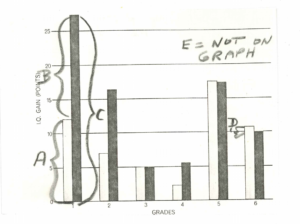Given the importance of teacher expectations in molding student performance, it is a shame that too often, teachers expect less from some students owing to their scores on “standardized tests.”
The key book on teacher expectations came out in 1966: Pygmalion in the Classroom. The authors, Rosenthal and Jacobson, summed it up in a readable article that spring in Scientific American. Another key piece of research came from two graduate students in sociology, Harvey and Slatin. They showed that teachers are all too willing to form snap judgments about students merely on the basis of photographs, and their judgments are heavily influenced by race and social class.
A third classic piece of research was contributed by James Rosenbaum, Making Inequality. It contains powerful anecdotal evidence showing how public school tracing creates students from whom more is expected and others expected to be dull.
Finally, Whistling Vivaldi shows how the form of “standardized” tests, and their position in our culture, helps create bad performance on them by African American students.
Chapter 2 of Loewen’s Teaching What Really Happened sums up this entire section.
This Scientific American article caused a wave of research in the sociology of education. Educators realized that the way kids dress, how they comport themselves, their race and gender, and whether they are “tracked” influences how teachers (and others) treat them and hence their performance.
Here is another research study, by another Rosenthal, showing the effect of teacher expectations on white adults.
Loewen made a tiny PowerPoint slide show to get across these points about “standardized” tests and teacher expectations.
Questions related to the Key Rosenthal and Jacobson Bar Graph
 The bar graph comes from Rosenthal & Jacobson article in Scientific American.
Circle the letter(s), A, B, C, D, or E referencing the bar graph.
The bar graph comes from Rosenthal & Jacobson article in Scientific American.
Circle the letter(s), A, B, C, D, or E referencing the bar graph.
- Best evidence that in normal populations, IQ is not determined by genetics.
- Evidence of the Hawthorne effect.
- Evidence of the Rosenthal or expectancy effect.
- Evidence that Black students suffer most from teacher expectations.
- Evidence that the experiment didn’t really work except in first and second grades.